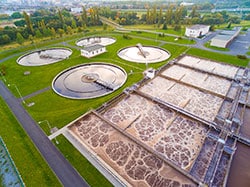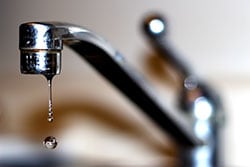Have you ever stopped to think about how many times a day you use water from a faucet? Learn more about where your drinking water comes from and what makes it safe to use during Drinking Water Week (May 3–9, 2020).
Drinking water refers to the water that comes out of our tap or bottled water. Every day, people rely on safe drinking water in many different ways, such as for handwashing, bathing, cooking, washing clothes, and drinking.
The United States has one of the safest drinking water supplies in the world, and it’s important to know how that water gets to our faucets and what makes it safe to use. Protecting our water sources is an ongoing challenge. However, controlling wastewater discharges or broken septic systems near drinking water sources can greatly reduce germs in our source water.
Drinking Water Week
Drinking Water Week is an annual observance sponsored by the American Water Works Association in May to recognize the critical role drinking water plays in our daily lives. This year’s theme, “There When You Need It,” highlights the work water professionals do around-the-clock to ensure high-quality drinking water is always available at your tap, right when you need it.
Although the United States has one of the safest drinking water supplies in the world, we must continue to work to protect our water sources.
Keeping Tap Water Safe and Healthy
Over the last 100 years, many improvements in the health, success, and lifespan of the U.S. population can be linked to improvements in water quality. Providing safe drinking water was one of the most important public health achievements of the 20th century. Water treatment and disinfection (methods to reduce germs or chemicals that cause illness) have helped ensure access to healthy and safe water for millions of Americans.
Government regulations have helped reduce pollution of the bodies of water that supply our drinking water systems over the years. However, treating water to kill or remove contaminants like harmful germs or chemicals is still critical to making sure that water is safe to drink. Drinking water can become contaminated at multiple points. These include:
- In the original water source (for example, a river)
- Through inadequate water treatment
- In storage tanks
- In drinking water distribution systems (the pipes that carry water to homes, businesses, schools, and other buildings)

Treating water to remove or kill disease-causing contaminants is critical to public health and the environment.
The Environmental Protection Agency (EPA) regulates drinking water quality in public water systems. Every public water system is required to provide its customers with an annual consumer confidence report (CCR), which provides information on local drinking water quality.
In addition, CDC’s Environmental Public Health Tracking Network has information and data about some of the most common environmental chemicals that may be found in community water supplies.
Drinking Water and Private Wells
EPA regulations do not apply to privately owned wells, although some states do regulate private wells. As a result, the 43 million Americans who get their water from private wells are responsible for ensuring that their tap water is safe from contaminants. If you have a well, you should take steps to protect it and have the water tested annually to make sure your water is safe from harmful germs and chemicals. A local health department or well water system professional may also provide assistance on well maintenance, new well construction, and water quality testing. CDC’s Safe Water for Community Health (Safe WATCH) program also helps health departments reduce harmful exposures from wells and other private drinking water systems.

Water System Challenges
Drinking water systems in the United States are up to 100 years old in some places. Cracked pipes, water main breaks, and other age-related issues increase the chance for germs or chemicals to get into the water and can lead to boil water advisories. The American Water Works Association has estimated that it will cost nearly $1 trillion in the next 25 years to repair and expand our drinking water systems to meet the demands of a growing population. Other challenges include warming temperatures, which can affect our water supply, and contamination of water sources with harmful chemicals and toxins.
What CDC Is Doing
CDC works to address these drinking water challenges through its water-related research, prevention, and policy activities and programs, including the following:
Research on Health Impacts
- Providing support for state, local, and tribal health officials to investigate, report, and prevent illnesses associated with drinking water.
- Estimating the number of waterborne illnesses, emergency department visits, hospitalizations, deaths, and direct healthcare costs.
- Evaluating the health impacts and water quality associated with low pressure events in the distribution systems of public water systems.
- Developing improved laboratory methods for sampling, testing, and monitoring water quality.
Preventing Waterborne Disease and Protecting Public Health
- Developing guidance to ensure the safety of building water systems and devices after a prolonged shutdown.
- Working with EPA, state and local health agencies, and other partners to provide guidance on drinking water policy and research priorities.
- Working with national partners to provide technical assistance, training, and guidance on improving safe drinking water programs.
- Conducting surveillance for waterborne disease outbreaks associated with drinking water.
- Developing training for health department programs on how to strengthen services to people who use wells, cisterns, springs, and other private drinking water systems not covered by the Safe Drinking Water Act.
- Developing tools and resources to respond to water-related emergencies.
- Supporting public health agencies to strengthen their drinking water programs and address problems with wells and other private drinking water systems.
- Applying study findings to improve waterborne disease prevention outreach, education, policies, and practices.
- Improving water quality data to identify risks, prevent exposures to harmful contaminants, and address community concerns.
- Providing national leadership on community water fluoridation practice
